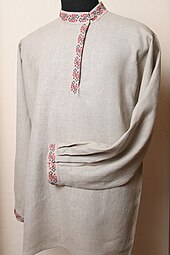Russian folk dance: Difference between revisions
Sohom Datta (talk | contribs) Restoring revision 1144689237 by Mellk: Please provide sources to justify the deletion (UV 0.1.4+310ce63) |
→top: Added links Tags: Reverted canned edit summary Mobile edit Mobile app edit Android app edit |
||
| Line 2: | Line 2: | ||
[[File:Театр танца "Гжель".jpg|thumb|260px|Russian folk dance [[Concert dance|concert]] performed by the dance ensemble Gzhel]] |
[[File:Театр танца "Гжель".jpg|thumb|260px|Russian folk dance [[Concert dance|concert]] performed by the dance ensemble Gzhel]] |
||
'''Russian folk dance''' ({{lang-ru|Русский народный танец}}) is an important part of [[Russian culture]]. Some of the unique characteristics suggest that many elements were developed by the early Russian population. |
'''Russian folk dance''' ({{lang-ru|Русский народный танец}}) is an important part of [[Russian culture]]. Some of the unique characteristics suggest that many elements were developed by the early Russian population. |
||
{{Infobox music genre |
|||
| name = Russian folk dance |
|||
| native_name = Русский народный танец |
|||
| instruments = {{hlist|[[Percussion]]|[[balalaika]]|[[accordion]]|[[vocals]]}} |
|||
| cultural_origins = Ancient, Slavic traditions, [[Balkans]] |
|||
| derivatives = [[Polka]]}} |
|||
==History== |
==History== |
||
Revision as of 21:44, 16 October 2023


Russian folk dance (Template:Lang-ru) is an important part of Russian culture. Some of the unique characteristics suggest that many elements were developed by the early Russian population.
| Russian folk dance | |
|---|---|
| Native name | Русский народный танец |
| Cultural origins | Ancient, Slavic traditions, Balkans |
| Typical instruments | |
| Derivative forms | Polka |
History

Many Russian dances became known from the 10th century. Russia witnessed various invasions from other countries. Due to its location and size the country also came into contact with many different cultures through migration and trading. In turn, a Eurasian cultural mix of music and dance helped develop Russian folk dances.[1]
Many of these early dances were performed and practiced by the lower classes. Typically the upper classes would watch performers rather than participate in the dances themselves.
The original Russian folk dance traditions continue to play an important part in the culture of the country and have been in constant interaction with Russia’s many ethnic groups.[2] Russian folk dances are also in interrelations with other types of artistic expressions.[3] One example can be seen in the Ballets Russes, which invokes Russian folk dances and music in its pieces.
Costumes

Costumes for concert dance are beautifully designed with great detail. Typically, the clothing for the dances is based on specific events, such as holidays, and varies between these events. Women wear holiday headdresses, embroidered shirts, belts, and ornamented aprons. Men wear shirts, a belt, narrow trousers, and high red boots. The color red is incorporated in many of the costumes because it is associated with beauty in the Russian tradition. In Russian dances woman and girls often carry a pocket square with them. Girls and women often wear the traditional Russian headdress kokoshnik during performances.[4]

Characteristics
Both furious and gentle music is the basis for Russian dances.[5][6]
Probably the most famous characteristics of Russian male dances are the Russian squat work (knee bending elements), stomping and the split jumps (also Russian split or Russian jump). Split jumps exist in similar forms in Chinese dance.[7][8] Dance features of this kind usually use expeditious music which changes its tempo over time.[9][10] Russian squat work and knee bending movements are usually carried out by the male dancers.[11] In Russian dance it is also common for male dancers to stomp, clap and strike the sole, front of the foot, thighs, knees and the chest with their hands held flat, similar to the German Schuhplattler, but in a much faster tempo.[12][13]
The Russian circle dance Horovod has its roots in ancient Slavic traditions and exists in similar forms in Balkans (Choros in Greece), in Middle Eastern cultures and in China.[14]
-
One of the largest shows featuring Russian stage folk dances is Gzhel in Moscow
-
Folk festival in Belgorod region in May 2015.
-
Illustration "Russian national dances - Cossack" (Tańce Narodowe Ruskie Kozak) from polish painter Kajetan Saryusz-Wolski from 1901
-
Russian dancers, 1922
-
Pyatnitsky Choir in 1900 - 1910 (Watch style and different elements of Russian folk dance and music from the Pyatnitsky Choir, performed by males and females on YouTube)
Russian dances
See also
References
- ^ "Traditional Russian Folk Dance". RusMoose.com. 2015-12-30. Retrieved 2018-10-16.
- ^ "Traditions of Russian Folk Dance :: Manners, Customs and Traditions :: Culture & Arts :: Russia-InfoCentre". www.russia-ic.com. Retrieved 2018-10-16.
- ^ "MOSCOW STATE DANCE THEATRE GZHEL". www.russianmusicandvideos.com. Retrieved 2018-11-03.
- ^ Guzeva, Alexandra (2018-07-18). "8 fascinating facts about kokoshnik – the quintessential Russian headdress". Retrieved 2018-10-16.
- ^ WeiT Media (2017-03-19), "Танцуют все!". "Калинка" (ансамбль "Сибирский сувенир"), retrieved 2018-10-16
- ^ vik22vik (2012-12-06), БЕРЁЗКА- BERIOZKA- ENSEMBLE FOLKLORIQUE RUSSE, retrieved 2018-10-16
{{citation}}: CS1 maint: numeric names: authors list (link) - ^ "Artist Profile: Hsiao-Hung Lin - Shen Yun Performing Arts". de.shenyun.com (in German). Retrieved 2019-03-09.
- ^ Shen Yun Official Account (2018-09-02), Shen Yun 2019 Official Trailer, retrieved 2019-03-09
- ^ WeiT Media (2017-04-30), "Танцуют все!". Русский народный танец. "The First Crew", retrieved 2018-10-16
- ^ WeiT Media (2017-04-02), "Танцуют все!". Народная хореография. Формейшн "Вера", retrieved 2018-10-16
- ^ Timokhin, Yuri. "Kalinka song and dance". RusClothing.com. Retrieved 2018-10-16.
- ^ Tatiana Smorodinskaya; Karen Evans-Romaine; Helena Goscilo, eds. (2012). Encyclopedia of Contemporary Russian Culture. Routledge. p. 215. ISBN 978-1283882927. OCLC 843080802.
- ^ WeiT Media (2017-04-30), "Танцуют все!". Русский народный танец. "The First Crew", retrieved 2019-03-09
- ^ Snodgrass, Mary Ellen, author. (2016). The Encyclopedia of World Folk Dance. p. 130. ISBN 9781442257481. OCLC 946160558.
{{cite book}}:|last=has generic name (help)CS1 maint: multiple names: authors list (link)





